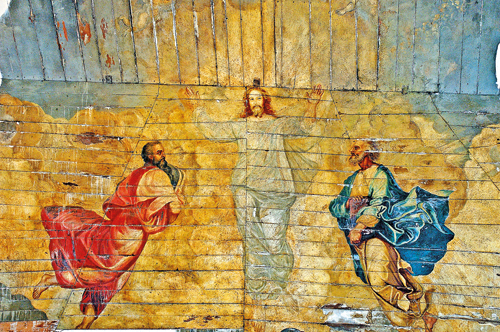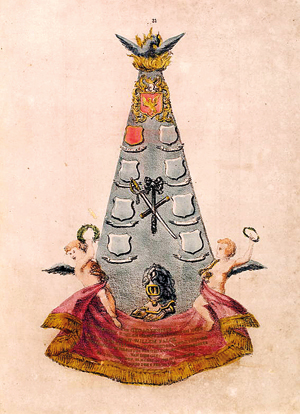Lost in time, the works of a little known artist

The Transfiguration of Christ: St. James Church, Mutwal Ceiling. Pic by Dominic Sansoni, ThreeBlindMen
His name is little known today but Richard Henricus, the artist, painter and illustrator was a younger contemporary of J.L.K. van Dort.
Whatever remains of Henricus’s work, mostly of a religious nature, is to be found in the naves and walls of Catholic churches in Mutwal and Kotahena. But rare examples of murals attributed to him are tucked away in the Buddhist temples of Dematagoda, Grandpass and Bambalapitiya.
Dr Lucian de Zilwa, recalling his schooldays in his autobiography, Scenes of a Lifetime (1967), remembers how in 1893, he was required to retain Henricus to paint the backdrop for a school play. “I had to find and engage Richard Henricus, whom I consider to have been the greatest artistic genius this country has produced. You have only to go to St Andrew’s Church in Mutwal, and look at the frescoes on the walls.” Unfortunately, the St Andrew’s Church complex was demolished in the 1940s and today no trace of these frescoes remains.
Some of the best examples of Henricus’s genius can however still be seen at St. James’ Church Mutwal. Built in 1864, this church is located on a promontory overlooking the harbour. The interior of the church has a high curved, timber boarded ceiling, 59 feet at its highest point, and as you enter the Church, your eye is immediately drawn to the ceiling.
At the far end, high above the nave leading to the altar is a magnificent painting of the Crucifixion. At the opposite end of this wooden ceiling, over the choristers’ balcony that spans the entrance to the nave is an equally awe-inspiring painting of the Transfiguration of Christ.
Borrowing heavily from the paintings of the Italian Renaissance, the dramatic Crucifixion scene in particular, with its heavily muscled supra-contorted figures appears to owe much to its inspiration from the work of Michelangelo. The Transfiguration scene on the other hand conveys a sense of tranquillity, its subtlety in marked contrast to the dramatic effects at the other end. The face of the transfigured Christ in particular, is superbly delineated.
Due to its exposed location close to the ocean, the church and roof of the building had to weather years of high monsoon winds and rains and the paintings are much the worse from wear. Rainwater has seeped in through the tiles and damaged the wooden ceiling boards. Attempts at partial restoration have not helped. The edges of the paintings stop abruptly and leads one to wonder whether there could have been very much more of the ceiling that was originally painted before well-meant colour-washing of a later date obliterated parts.

A panel by Henricus still seen at Wolvendaal Church in Pettah
Henricus is also said to have painted the walls and the side panels below the ceiling, on which scenes from Christ’s life are depicted. The walls bear no trace of his work and all but one of the panels has now been repainted by another hand. The only panel that retains his original work has a painting of the Last Supper, in which a young waiter in the background is said to be a self-portrait of the artist.
Henricus is also believed to have painted the portraits of the four Evangelists found below the cupola at St Lucia’s Cathedral.
In 1877, Leopold Ludovici, an Editor of the Examiner Press published a limited-edition work titled Lapidarium Zeylanicum. This featured coloured lithographic engravings of the crests and heraldic signs of the 17th and 18th century high officials of the Dutch East India Company, and their families. The descriptive plates accompanied by copies of the inscriptions found on the monuments are the work of Richard Henricus, whose initials are appended at the bottom. Only 300 copies of this book were printed and it is one of the most sought after and rare books of the period.
Henricus’ close friend and colleague J.L.K. van Dort was a contributor to the monthly magazine the Muniandi (based on the English journal Punch) also brought out by the Examiner Press and is supposed to have supervised the creation of the Lapidarium Zeylanicum.
Two of Henricus’s charming engravings also appear in this book. One is of the Bell Tower on Main Street, Pettah (frontispiece) which announced the times of the service of the Wolvendaal Church and the other an interior of the building. Today, visitors to the Dutch Reformed Church, Wolvendaal can still see these same monuments in the church dating to almost two and a half centuries ago, and compare them with those depicted by Henricus and van Dort, in the 1870s.
Henricus was a regular contributor to the exhibitions of the Ceylon Society of Arts from its inception in 1891 through to the 1900s. The 1908 edition of the Ferguson’s Commercial Directory has an entry for Henricus that reads, “Henricus – Richard – Scenic Artist and Designer – Avondale, Maradana, Colombo”.
After 1917, Richard Henricus’s name disappears and is not recorded in the Ferguson’s Directory as an artist, engraver or sculptor in the Trade List for Colombo.
Henricus was regularly sought out to paint the backdrops for plays that were staged at the Tower Hall Theatre in Maradana, the popular venue for theatrical productions in the late 19th and early 20th century. The decorative style he adopted, a combination of romantic and theatrical naturalism that was a fusion of Indian and European styles, became characteristic of Tower Hall theatre productions. Apprenticed under Henricus was the young artist M. Sarlis, who adopted this distinctive style as his own and went on to become a famous temple painter popularly known as Sarlis Master.
The late 1800s saw a revival in Buddhist temple painting and Henricus’s contribution to this movement was the introduction of what became known as the “Transitional Style” embodying the elements of European perspective into traditional Buddhist temple art forms. He painted murals for the Buddhist viharas in Dematagoda and North Colombo including those at the Jayatillekerama Temple in Grandpass, where a fragment remained until recently. Sadly that too has now been re-plastered.
Richard Henricus is reputed to have had a brother named George with whom he shared some of his assignments and work and some believe it was George who was responsible for the paintings at St James’ Mutwal. Professor Senaka Bandaranayake, in his authoritative work The Rock and Wall Paintings of Sri Lanka (Colombo, 1986), confirms the existence of the brothers and attributes the Buddhist temple paintings to both muralists.
Searching for an ideal partner? Find your soul mate on Hitad.lk, Sri Lanka's favourite marriage proposals page. With Hitad.lk matrimonial advertisements you have access to thousands of ads from potential suitors who are looking for someone just like you.


